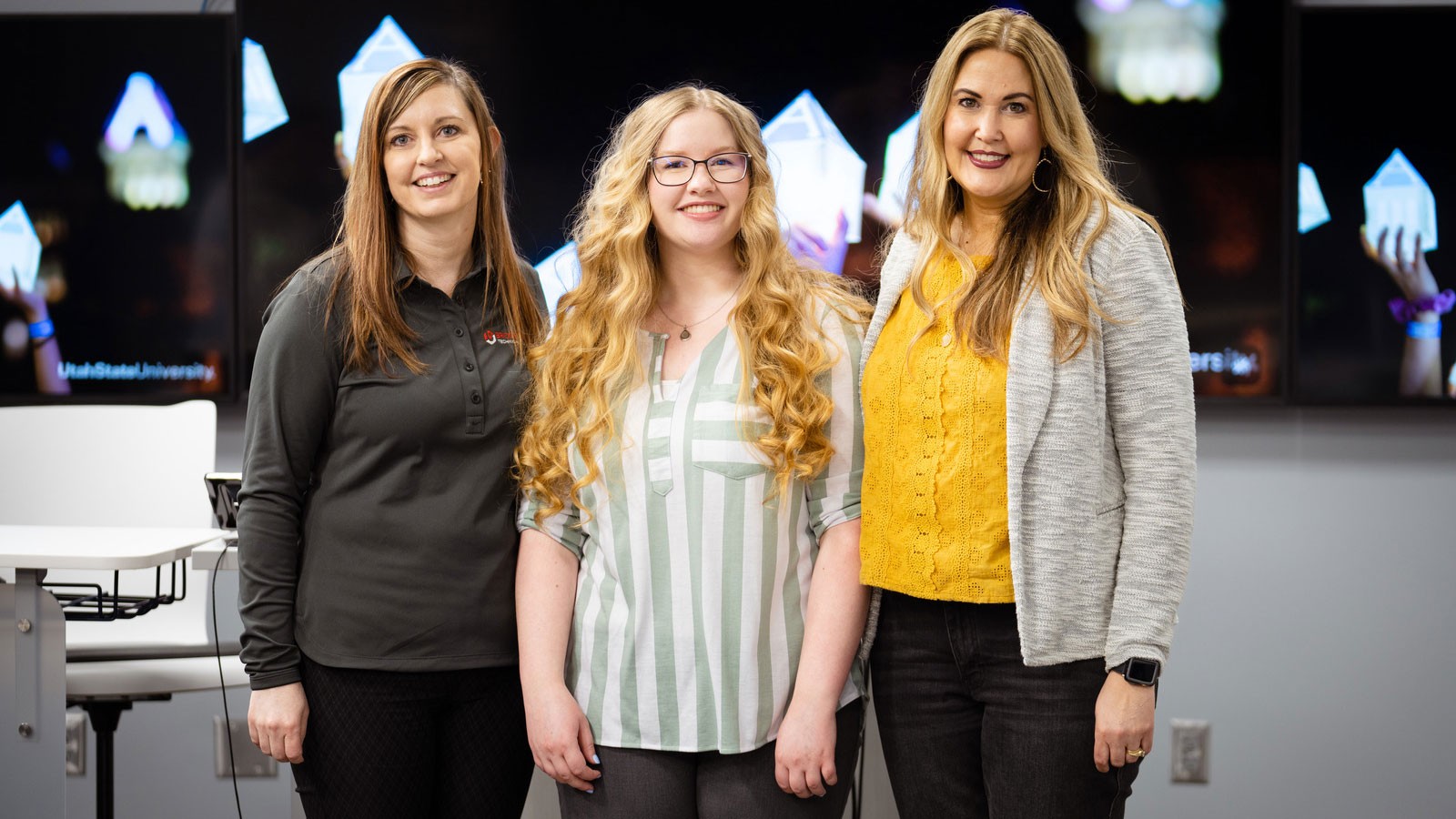Technology Systems Student Finds Success With 'Stackable' Education
By Shelby Ruud Jarman |
Emily Hudson, Sydnee Mabey and Lisa Hunsaker.
Sydney Mabey wasn’t sure she wanted to go to college. Uncertain of her professional goals, the idea of taking college classes that may or may not help her future career did not appeal to her.
“I'm very much a goal-oriented person,” Mabey said. “I need a clear path forward.”
But now, just two short years after finishing high school, she’s graduating with her bachelor’s degree in technology systems from the Utah State University College of Agriculture and Applied Sciences.
Mabey began her educational journey at Bridgerland Technical College while still in high school and took advantage of the unique degree stacking program at USU to fast-track her education. This path allowed her to focus on specialized skills, graduate faster and avoid student loan debt.
Degree stacking, where credits earned toward certificates at USU or technical colleges throughout Utah can be applied to two- and four-year degrees at USU, is a great option for many students, according to Emily Hudson, a business instructor at Bridgerland Technical College.
“The stackable certificates and degrees really open up a lot of options to students,” Hudson said. “Some students come to school just wanting a certificate but then realize how much they enjoy learning and gain confidence that a more advanced degree is attainable. It is fantastic that they can use what they have learned and build upon it rather than having to start all over at square one.”
This flexibility is exactly what Mabey used to streamline her education. She took advanced placement and concurrent enrollment classes and began a Bridgerland program as a high school student. Two months after graduating from high school, Mabey completed the business technology certificate at Bridgerland Technical College. The program taught software and internet-based applications, accounting practices, leadership and entrepreneurship.
“I think a lot of people view technical and trade schools as lesser than universities, which I definitely wouldn’t agree with,” Mabey said. “If you want to get specialized, narrowed down skills without having to take a bunch of general classes, I think it's a great option. I've noticed a lot of employers are starting to look for those specialized skills.”
The business technology certificate stacked 30 credits toward her associate of applied science degree in general technology when she transferred to USU. Her advanced placement and concurrent enrollment classes from high school also transferred and allowed her to advance even faster.
“Students who complete concurrent enrollment courses and certificates while they are in high school save a lot of time and money because they can come in with over 30 credits,” said Lisa Hunsaker, the academic adviser for the Technology, Design and Technical Education Department. “This is at least two semesters of cost savings and time savings.”
After just two semesters at USU, Mabey earned her associate of applied science degree in the spring of 2022. To obtain her bachelor’s degree in technology systems, she only needed to complete two additional semesters and a summer internship, allowing her to graduate in the spring of 2023.
Education at a technical college and a university can go hand in hand, according to Zak Konakis, regional pathways coordinator and professional practice assistant professor in the Department of Technology, Design and Technical Education.
“Honoring the work and experience at the technical schools allows students to enter Utah State University poised for an associate degree that helps them capitalize on their skills gained at the technical schools and to go into business for themselves or earn degrees in areas that expand the ideas introduced during their certificates,” he said. “All of these approaches benefit students and open new opportunities for student development.”
During her years at Bridgerland and USU, Mabey also completed a bookkeeping internship with the accounting firm Jones Simkins LLC. This valuable experience taught Mabey how to work with clients and provide exemplary customer service, how to complete accounting and bookkeeping tasks, how to run accounting software like QuickBooks, how to work as a team player, and how to train and mentor new employees.
After graduation, Mabey plans to continue to work for Jones Simpkins LLC while keeping options open for a career in office management. The skills she learned at both Bridgerland and USU will help her succeed.
“I loved Bridgerland Technical College for certain aspects and USU for other aspects,” she said. “With the technical school, I got a lot of practical applications. It was a good foundation for when I did come to USU, where a lot of my studies have been more conceptual.”
“I wouldn’t have even attended a university if this program didn’t exist,” she added.
To learn more about stackable degrees, visit www.stackable.usu.edu or contact Hunsaker at lisa.hunsaker@usu.edu. Information about programs at Bridgerland Technical College can be found at www.btech.edu.
WRITER
Shelby Ruud Jarman
Writer
College of Agriculture and Applied Sciences
208-705-2282
shelby.ruud@usu.edu
CONTACT
Lisa Hunsaker
Academic Adviser
College of Agriculture & Applied Sciences
435-797-0851
lisa.hunsaker@usu.edu
TOPICS
Student Success 303storiesComments and questions regarding this article may be directed to the contact person listed on this page.







